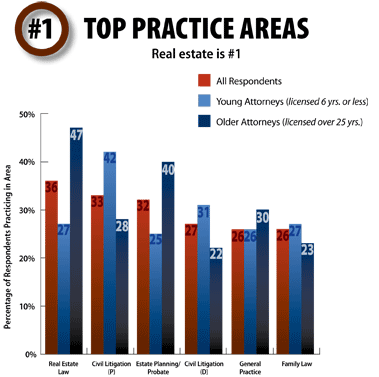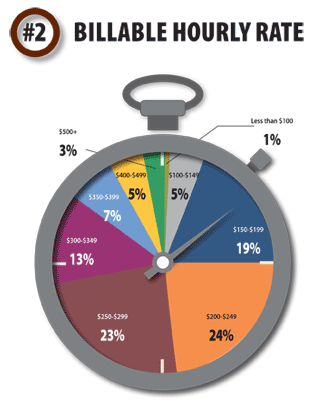ISBA Development Site
This website is for ISBA staff use only. All visitors should return to the main ISBA website.
This website is for ISBA staff use only. All visitors should return to the main ISBA website.
November 2014 • Volume 102 • Number 11 • Page 528
Thank you for viewing this Illinois Bar Journal article. Please join the ISBA to access all of our IBJ articles and archives.
The ISBA surveyed members in private practice in Illinois about their practice setting, compensation, and benefits. Here are the top takeaways.
The results from the ISBA's 2014 Compensation and Benefits Survey are in. The survey, which was spearheaded by the ISBA's Standing Committee on Women and the Law and championed by Immediate Past President Paula Holderman, was sent to members who are actively engaged in private practice with a primary office in Illinois. Its goal was to better understand the economic realities and workplace environments affecting these members. Readex Research conducted the online survey from June 4-16, 2014 and analyzed its results for the ISBA.
In total, the survey generated useable responses from 1,310 members. The typical respondent is 47 years old, has been licensed for 18 years, and has been practicing at his or her current firm for eight years. 65 percent of the respondents are male and 35 percent are female.
This article details the results from five areas of the survey that are likely to be of general interest. Please bear in mind that these results are only representative of ISBA members who are engaged in private practice and who voluntarily responded to the survey. Also, most results are reported using a median value, which is the value lying at the middle of all response values (i.e., 50 percent of values are below it and 50 percent are above). Because median values are not influenced by extreme values, they tend to represent the "typical" response. For a fuller discussion of the survey results, ISBA members can access the report at www.isba.org/2014compensationsurvey.
#1 Top Practice Areas
Real estate is #1
 Respondents were presented with a list of 35 common practice areas and asked to select all that they practice in. Each respondent selected an average of 4.1 practice areas and no single area was selected by more than 36 percent of respondents. Not surprisingly, respondents practicing at larger firms tended to select fewer areas than those at smaller firms. Solo practitioners selected an average of 4.3 practice areas, while respondents working at firms with 50 or more attorneys selected an average of 2.7.
Respondents were presented with a list of 35 common practice areas and asked to select all that they practice in. Each respondent selected an average of 4.1 practice areas and no single area was selected by more than 36 percent of respondents. Not surprisingly, respondents practicing at larger firms tended to select fewer areas than those at smaller firms. Solo practitioners selected an average of 4.3 practice areas, while respondents working at firms with 50 or more attorneys selected an average of 2.7.
The chart presented here includes the six practice areas selected by the largest percentage of respondents. Interestingly, older attorneys are significantly more likely than other respondents to practice in the areas of real estate and estate planning/probate. Young attorneys, on the other hand, are more likely to do plaintiff's side litigation.
The practice areas selected by the lowest percentage of respondents are mineral law, antitrust/unfair competition law, public utilities law, and animal law. Each was only selected by one percent of respondents.
#2 Billable Hourly Rate
 89 percent of the total respondents provided their billable hourly rate - 11 percent left the answer blank. The typical response was a billable hourly rate of $250, but as you can see in the chart, a wide range of rates were provided. Six percent of respondents providing an answer indicated a rate less than $150 and eight percent indicated a rate greater than $400.
89 percent of the total respondents provided their billable hourly rate - 11 percent left the answer blank. The typical response was a billable hourly rate of $250, but as you can see in the chart, a wide range of rates were provided. Six percent of respondents providing an answer indicated a rate less than $150 and eight percent indicated a rate greater than $400.
The survey results also show that an attorney's billable hourly rate tends to correlate positively with the size of the firm that he or she practices in. The typical hourly rate for solo practitioners was $225, while that of respondents in firms with 50 or more attorneys was $273. Respondents practicing in firms of 2-10 attorneys had a typical rate of $250 per hour, those in 11-19 attorney firms had a slightly lower typical rate of $225, and the average billable hourly rate for those practicing in firms of 20-49 attorneys was $250.
#3 Base Salary
The majority of survey respondents said they receive a salary from their firm. Specifically, 60 percent of all respondents receive a salary as a component of their compensation, including 53 percent who indicated that a salary is the only compensation they receive. For solo practitioners, only 23 percent reported receiving a salary. On the other end of the spectrum, 94 percent of associates at firms receive a salary, including 87 percent who receive only a salary. Partners at firms lie in the middle, with 53 percent receiving a salary, including 44 percent who receive only a salary.
The charts show the respondents' median base salary as a function of current position and firm size. Not surprisingly, base salary tends to positively correlate with firm size - as the size of a respondent's firm increases, so does his or her base salary. Likewise, partners at firms have higher base salaries than the typical respondent. While we haven't included a chart showing median base salary as a function of years licensed, the results of the survey do show that as the number of years licensed increases, so does the median base salary.
Finally, it is worth noting that the survey results show the typical male respondent earning $15,500 more than the typical female respondent. Readex Research, which conducted the survey and analyzed its results for the ISBA, notes that "[t]his is likely due, at least in part, to the abundance of males in partner roles compared to females and the differing levels of experience between the genders, on average." Specifically, out of all the respondents who said they are some type of partner at a law firm, 74 percent were male and only 26 percent were female. Also, the average number of years licensed for all male respondents is 20.9, compared to 14 years for all female respondents.
#4 Size of Firm
As the chart here shows, 26 percent of all respondents are solo practitioners, 73 percent work at firms with 10 or fewer attorneys, and only 17 percent work at firms with 20 or more. While the typical (i.e., median) attorney who responded to the survey works at a firm with a total of 4 attorneys, the average (i.e., mean) office size across all respondents is 9.7 attorneys. This average of 9.7 attorneys is made up of an average of 5.2 partners (4.1 male and 1.1 female), 3.5 associates (2.1 male and 1.4 female), .5 of counsel, and .2 contract attorneys.
Out of all respondents who are not solo practitioners, 48 percent are partners at firms and 43 percent are associates. The remainder are of counsel (4 percent), contract attorneys (2 percent), and "other non-partner" (3 percent).
#5 Hours Worked Per Week
Despite the cliché that self-employed people work for a brutally demanding boss, solo practitioners as a group report putting in fewer total hours at the office than respondents as a whole.
Timothy A. Slating is the ISBA's Assistant Director of Publications and the Assistant Editor of the Illinois Bar Journal.